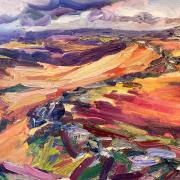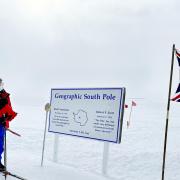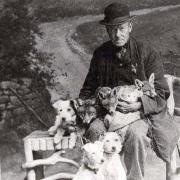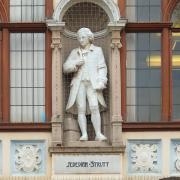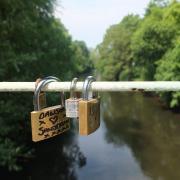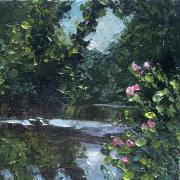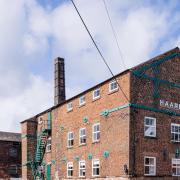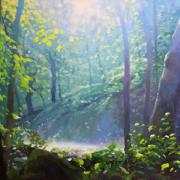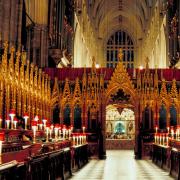Award-winning author Berlie Doherty talks to Mike Smith at her idyllic home in the Vale of Edale
Once upon a time, Berlie Doherty was in the habit of driving into the Derbyshire countryside from her home in Sheffield. On some occasions, she would take her children on camping expeditions in Edale or the Hope Valley. At other times, she would travel alone to a Peak District beauty spot, where she would sit in her car and write stories.
One of the tales that resulted from these trips was White Peak Farm, a novel which was adapted as a TV mini-series. Although the televised version was filmed, on some producer's whim, in Northumberland, the original book was clearly inspired by Berlie's love of Derbyshire and her long-held desire to live on a farm.
Fifteen years ago, she decided that it was high time that she converted her fantasy into reality. Together with her partner, fellow children's author Alan Brown, she moved to a cottage in the Vale of Edale. Even though the house is located in the Dark Peak, rather than the White Peak, and stands next to a farm, rather than on one, it has more than satisfied her dream and remains her home to this day.
When I met the author in her cottage, which is idyllically located in a remote hamlet at the foot of Kinder Scout, she told me about the equally idyllic location where she spent most of her childhood. Although Berlie was born in Liverpool, she moved at the age of four to Hoylake, on the Wirral Peninsula. The family house overlooked the sea and stood close to an offshore island that could be reached on foot at low tide. It was an inspirational setting for a young girl who loved to make up stories.
The budding writer received encouragement from her father, a railway clerk, who wrote pieces for railway journals and had aspirations to be a poet. Further inspiration came in the form of Arthur Ransome's Swallows and Amazons, which was recommended to her by a local librarian. She recalls, 'When I read that book, it was as if a door to a whole new world had been opened.'
Public recognition came early for Berlie, because many of her stories and poems were published in the children's pages of the local newspapers, with payment coming in the form of chocolates and boxes of paints. She says: 'At the time, I thought that all writers must be paid in this way. Needless to say, I enjoyed my first writing career, but it came to an abrupt end at the age of fourteen, when I received a letter informing me that my pieces could no longer be accepted for the children's pages because I was too old. I was devastated.'
Berlie was also frustrated at that time by the lack of reading material at her convent school in Upton. She recalls, 'The only books I can remember being available at the school were ones about the lives of the saints - and they were kept in locked cabinets!' However, a lay English teacher came to Berlie's rescue by giving her free access to her home library, where she immersed herself in the works of American and Irish playwrights.
On leaving school, Berlie went to Durham University, where she read for a degree in English Literature. Rather than re-igniting her writing career, her studies put a further damper on it. She says, 'When I read the set books on the course, I felt that there was no way that I could compete with all these great writers - they represented something that was unattainable."
In fact, her writing career was put on hold for several more hectic years, during which she gained a post-graduate qualification in Social Science at Liverpool University, got married, moved to Sheffield, had three children, got divorced and then embarked on a teacher training course at Sheffield University. Her resurrection as a writer came on the day when the course tutor, Bernard Harrison, asked all his trainee teachers to write a short story. Berlie penned a tale based on a nun who had taught her at convent school. Bernard was so impressed by the piece that he suggested it should be submitted to BBC Radio Sheffield, where it was snapped up by producer Dave Sheasby. Rather than receiving paints and chocolates as payment on this occasion, Berlie was paid the princely sum of �8!
After completing her course, Berlie took up a teaching post in a Sheffield school but continued to write in her spare time. She says, 'Most of my stories then, as now, were based on a mixture of "I Remember" and "Let's Pretend". To demonstrate this technique to my pupils, I read one of my stories to my class in ten instalments. It was about the experiences of a girl at a convent school and called How Green You Are! - green was the colour of my school uniform.'
This story was later broadcast on Radio Sheffield, where Berlie took a two-year secondment to write and produce educational programmes. After completing the secondment, she felt confident enough to become a full-time writer. Her early stories included references to her grandfather, who spent time at sea, and her protestant father and catholic mother, who married secretly during one lunch break and only released news of their wedding six weeks later!
Chance occurrences often trigger new stories. One day Berlie was admiring a picture of two 'buffer girls' in Sheffield Art Gallery and pondering on the meaning of the title when she overheard a lady next to her saying, 'My granny was a buffer girl'. Berlie's novel Granny Was a Buffer Girl won her the 1986 Carnegie Medal, awarded annually to 'the author of an outstanding book for children'. She received the prestigious award again in 1991 for Dear Nobody.
Granny Was a Buffer Girl was originally written as a series for Radio Sheffield and Dear Nobody has been adapted for radio, television and the theatre. Berlie loves converting her work into stage plays, which she sees as 'living, fluid things that are energised by the producer, designer, musicians and actors', but she is equally fond of writing for radio, because 'radio invites both writer and listener to use their imagination, to "see" with their mind's eye.'
Back in 1980, Berlie wrote a radio play in which the voices of drowned children are heard. Some years later, she visited Ladybower Reservoir at a time of drought and saw the remains of the village that had been destroyed to make way for the reservoir. On another day, when the waters were very still, she saw reflections in the lake that were a perfect mirror image of the real landscape. These two observations were the prompt for Deep Secret, a book that centres on identical twins, one of whom dies in a village that is itself about to die in order to make way for a reservoir.
Children of Winter is another of her books that is set in the Peak District. It tells the story of three siblings who take shelter from a sudden storm in a barn, where they begin to imagine that they are living in the 17th century as children who have been placed in quarantine in order to protect them from the plague in nearby Eyam. The reader can identify completely with the 17th-century children, even though their parts are being played by children from our own times. As Berlie demonstrates, a child's sense of fear and isolation is timeless.
First published by Methuen in 1982, this book was recently re-published by Catnip to mark Berlie's 25th anniversary as a writer. During the last quarter of a century, she has written over 50 books for children, teenagers and adults, numerous plays for radio, television and the stage, and several librettos, written in association with the Lindsay String Quartet and, more recently, the Welsh National Opera.
There will be a further addition to this remarkable body of work in July, when Berlie's new novel will be published. Like so many of her other stories, this latest tale is set in the Derbyshire countryside. It comes as no surprise to find that she has used the immediate surroundings of her idyllic Edale cottage as a backdrop on this occasion, but the subject matter is rather less expected. The book is entitled A Beautiful Place for a Murder.





